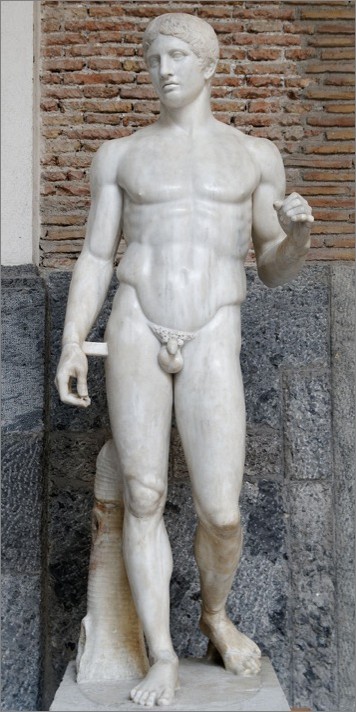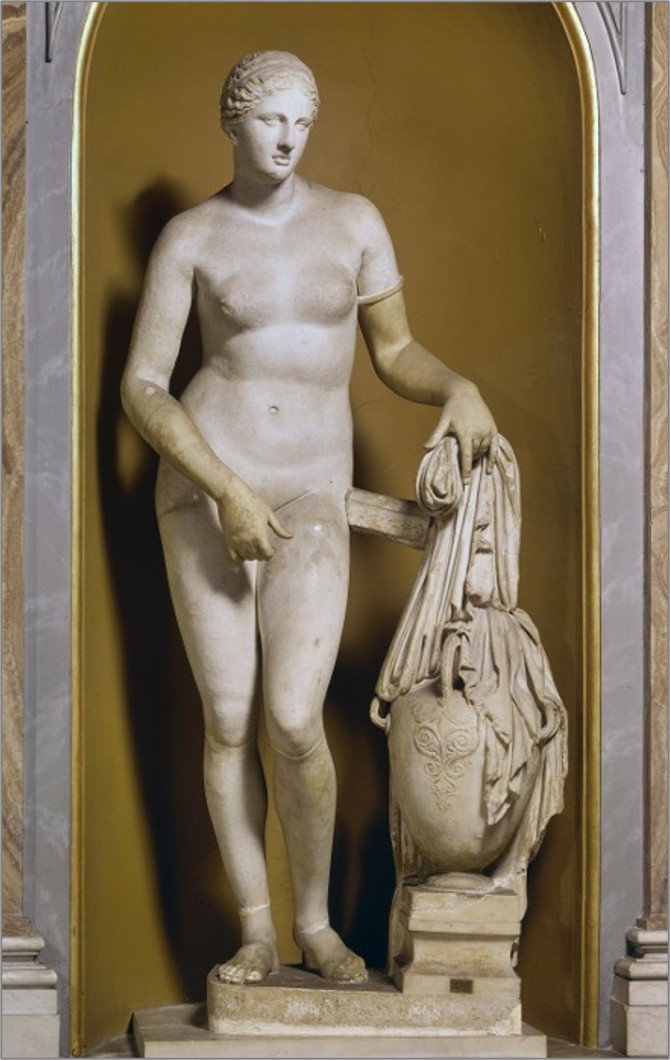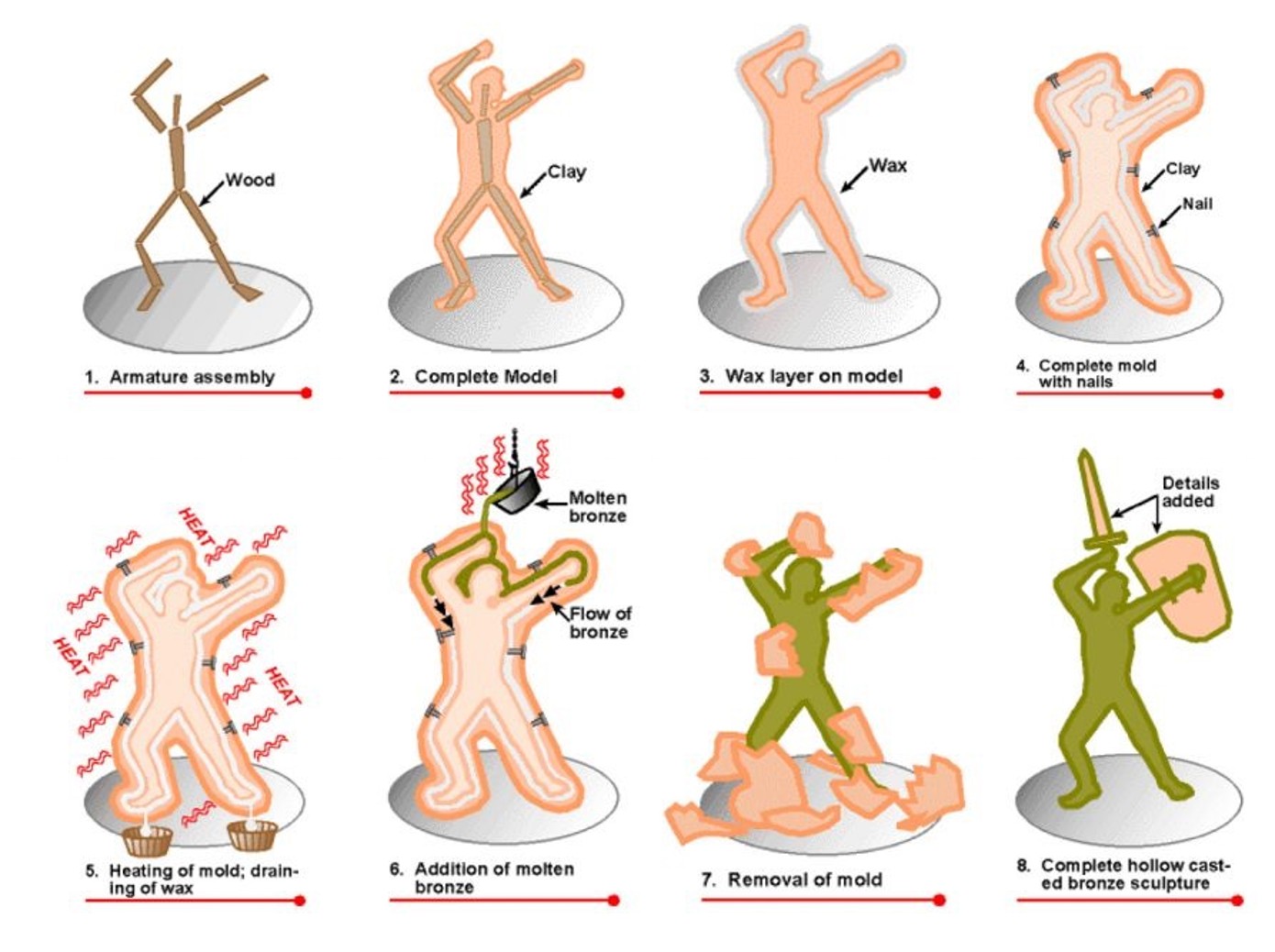前古典时期
古希腊文明的前身是克里特岛及其他爱琴海群岛上的青铜器时代爱琴海文明。
基克拉泽斯(Cycladic)文明:原始的大理石陵墓雕塑。
米诺斯(Minoan)文明:宫殿装饰中的一些自然主义设计(鱼,乌贼,鸟,圣母百合等)。
雅典与古典传统的形成
关于古希腊的一些 Context。
城邦(polis)古希腊社会的基本政治单元。
- 卫城(Acropolis):希腊语直译为「最高的城」,为城邦的核心区域。常建于陡峭山丘之上,兼具宗教场所,军事要塞,贵族居所等多重功能。
- 集市广场/阿格拉(Agora):城邦的核心公共空间。
- 神庙/圣所(Greek temple):安座神像,存储贡品。内部并非公共场所,祭礼常在神庙外举行。
=> 帕特农神庙(Parthenon),建于雅典卫城之上。 - 体育场(Greek gymnasium):浴场与体育训练场。
雅典(Athens):
- 有限民主:赋予男性公民政治权利,公共决策权,兵役。女性,奴隶与外邦人被排除。
- 性别经济(gender economy):男性公民控制政治,公共生活与战争;女性被限制在家庭(oikos)内部,负责生育,家务与宗教仪式;奴隶和外邦人提供经济与劳力支撑。
- 城邦守护神为战争与智慧之神,雅典娜;对应雅典价值体系中的军事(martial)与道德(moral)精神。
雕像与古典理想主义
英雄化(heroic)的男体=>《掷铁饼者》米隆(Discobolus,Myron)
=>《持矛者》波留克列特斯(Doryphoros,Polykleitos)
=> 强调体能,力量;肌肉结构清晰,充满张力;自然放松的
=>《克尼多斯的阿佛洛狄忒》普拉克西特列斯(Aphrodite of Knidos,Praxiteles)
=> 强调柔和,纤细;羞涩,扭动的姿态;女体从神秘的象征,逐渐成为欲望、感官和理想美的表达。


陶器绘画与叙事
战争与英雄个人主义(heroic individualism)叙事,戏剧与场景绘画(scenic painting) 与 工匠(craftsman)即艺术家=>《阿喀琉斯与阿贾克斯在下棋》埃克塞基亚斯(Achilles and Ajax Playing a Board Game,Exekias)
=>《特洛伊战争中萨尔珀冬之死,与战士们武装自己》画师:Euphronios,陶匠:Euxitheos(Death of Sarpedon during the Trojan War and Warriors Arming Themselves, Euphronios [painter] & Euxitheos [potter])
- 少见的同时标明画师与陶匠的陶器:工艺与艺术的关系?
本节名录
- terracotta (赤陶): pottery made from clay (黏土) baked at a relatively low temperature and decorated with paint rather than glaze (釉) (glaze gets re-baked to become shiny).
- fresco (湿壁画): a wall painting technique in which pigments (颜料) are applied to a wet plaster (灰泥) surface, which dries to become part of the wall.
- the Iliad by Homer (荷马《伊利亚特》): an epic Greek story in verse recounting the Trojan war, fought between Athens and Troy after the abduction of Helen, early 8th c. B.C.
- Athena (雅典娜): the Greek goddess of war, wisdom, and the arts; patron goddess of Athens; equivalent to Minerva (密涅瓦) in Roman mythology.
- Aphrodite (阿芙洛狄忒): the Greek goddess of love and beauty, later associated with the Roman goddess Venus (维纳斯).
- lost-wax bronze casting (脱蜡铸铜): a bronze sculpting technique used in early Greece; one shapes the form in clay, covers it with a thin layer of wax, and covers the wax with a clay mold; then one melts away the wax and fills the emptied space with molten bronze, which cools and replicates the thin wax shell.
